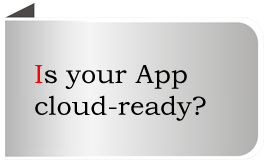

Is your App cloud-ready?
As soon as a cloud environment is considered, there are some fundamental decisions that IT managers have to make: which applications and services are best suited for a dynamic environment like the cloud?
However, before we answer this question, let us take you through a quick 8 step guide to what cloud apps actually mean:1. Cloud-based applications or cloud apps are applications hosted on a cloud platform either within an organization or with a managed service provider. It helps enhance mobility, connectivity and accessibility to the application.
2. Cloud apps simplify data storage and maintenance.
3. Accessibility and Control - With the help of cloud apps, multiple parties in different locations can 'sync up' or collaborate on data documents. This saves time without jeopardizing file security and back-up, and reduces loss of critical data.
4. Automatic software updates - Automatic updates ensure all users are on a standardized and latest software version.
5. Costs of cloud apps - Customers can reduce capital expenditure on servers or software licensing. Providing apps on a common user interface also helps reduce costs incurred by conventional app maintenance. Apps on the cloud offer the added advantage of paying for a service only when required, thereby reducing operational expenditure.
6. Cloud-based apps are data saviors - Cloud based apps provide businesses with automatic data recovery. Enterprises do not need to concern themselves with installing complicated software and back-up plans to ensure the safety of their data because that is automatically saved on the cloud.
7. Businesses are keen to migrate to cloud-based apps as they are flexible
8. By virtualizing IT and moving away from physical infrastructure into a virtualized cloud data centre, enterprises can leverage cloud apps to create a customized internet experience for applications.
Now that you have a fair idea about Cloud Apps, it's vital for you to determine cloud-readiness of various apps. It is important to know that no matter which platform your current applications run on, a certain degree of preparation is required in order to ensure they can successfully migrate to the cloud. Fundamentally, applications are either 'cloud-ready' or 'cloud-centric'.
Cloud-ready applications can migrate to either a public or a private cloud. Some applications might not function well on the cloud due to design limitations of the application. However, some applications are designed to take advantage of the capabilities provided by cloud, so this needs to be evaluated thoroughly.
Here are a few things to consider for determining the cloud-readiness of your application:
1. Inter-dependency of the application to know if the application is multi-tier, has active directory requirements and if any external application is leveraging it.
2. Network dependencies to know if the application has firewall rules and how are users accessing the application.
3. It is also important to know how an application is administered - if it has an admin web interface, secure shell access or terminal server.
4. IT teams must also determine if the interface of the application is compatible with the cloud or not.
5. When a company is thinking about moving an application to the cloud, it is a must for them to know the current storage requirements of the application.
6. Applications that have similar SLA requirements can be grouped in order to bring down management costs.
7. Applications that are constantly being upgraded and require customization are not suitable for the cloud. It's a good idea to strike-off those applications that would require modification or complete re-structuring of their internal design.
Finally, the move to the cloud is a good decision! Here's why:
1. Hosted Cloud applications' infrastructure can be entirely managed by your managed cloud service provider
2. Hosted Cloud servers are maintained by a service provider possessing the specialized technological expertise
3. Data centers of cloud providers are usually equipped with multi-layered security systems and hence cloud solutions can provide more secure data hosting.
4. Cloud providers offer regular updates automatically, saving businesses the trouble of acquiring more advanced applications and giving them a competitive advantage in the process.
5. Economies of scale can be achieved through cloud computing with a service provider because of economies of scale offered by a service provider.
6. The expense of hiring specialized IT professionals to manage in-house servers is higher than acquiring the services of a cloud provider.
7. Purchasing and maintaining back-up hardware in case an in-house server fails will not be required and idle resource investment and storage can be avoided.
Now that you know that migrating to the cloud is the only way forward and also have a good start to determining the cloud readiness of your applications, it is time to choose the right cloud vendor to maximize the value of the cloud.
Some important factors to consider when choosing a cloud vendor are:
1. Check if the products and services offered by the cloud provider suit the needs of your business and if it can help achieve the overall goals of your company.
2. Check if the cloud provider is a stable and reputable company, offering good value for money within your allocated IT budget.
3. Finally, it is vital to ensure that the service provider offers good technical support and will provide help in the migration process to make your move to the cloud as smooth as possible.
Migrating apps to cloud have numerous benefits for a business, including more technologically advanced applications, increased agility and cost reduction, giving companies an edge over competition.
As more and more companies emerge in 2014 to offer cloud solutions, the writing is on the wall - or should we say the cloud? Cloud apps are here to stay. And being early adopters could put your business ahead in the race.
